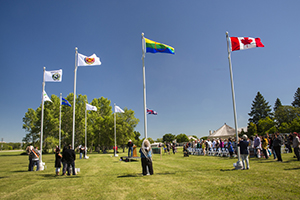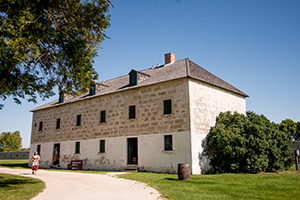What makes Lower Fort Garry unique?
Lower Fort Garry National Historic Site
- It was the place where Treaty No. 1 was made between the Anishinaabe and Swampy Cree First Nations people and the Crown
- As a Hudson's Bay company post, it was a focus for industry and transport, as well as a supply and distribution centre for the fur trade of the company's Northern Department
- It is one of the finest collections of early stone buildings in Western Canada
- It was used by the federal government for public purposes in the 1870s, notably as the first training base for the North West Mounted Police
It was the place where Treaty No. 1 was made between the Anishinaabe and Swampy Cree First Nations people and the Crown

Lower Fort Garry was a major business site for all in the Red River Settlement. Besides outfitting farmers and trappers with their yearly supplies, the Indigenous communities in the surrounding areas also conducted much business with the Hudson's Bay Company. Many Indigenous peoples would trade their leather goods, farmed crops and dried fish with the Company, and more still would work for the Company by taking part in the yearly buffalo hunts.
This continued well into the 1850s and 1860s, with many Indigenous women working on the Company farms, and the men working the small fishery on the Red River.
In 1871, Treaty No. 1 was signed at Lower Fort Garry, and a plaque commemorating this treaty has been placed outside the West Gate of the Fort.
Learn more:
Treaty No. 1 - Treaty Relations Commission of Manitoba
As a Hudson's Bay company post, it was a focus for industry and transport, as well as a supply and distribution centre for the fur trade of the company's Northern Department
The journey for York boats from Hudson's Bay to the Red River Settlement was nearly 1100 km (700 miles) and contained dozens of gruelling portages. Each York boat would contain three tons of supplies, all of which had to be portaged in 91 kg (200 lbs) loads on tripmens' backs.
While the upper fort was a good shipping fort due to the junction of the Red and Assiniboine rivers, the St. Andrew's Rapids (which created yet another portage) and the yearly threat of flooding created the need for a site that was on high ground and avoided the rapids.
Lower Fort Garry became, for a short time, a major transshipment post for the Hudson's Bay Company. This, combined with the ample Company space able to house hundreds of hired tripmen to work the boat runs, made the lower fort an ideal site for this task.
It is one of the finest collections of early stone buildings in Western Canada

Lower Fort Garry is home to several different architectural designs that flourished in the fur trade era. The fact that there was wood 32 km (20 miles) to the north as well as a generous supply of limestone at the fort, enabled several different methods of construction to be used in the settlement. Designs using both stone and wood abounded in the settlement back then, and the current historic buildings are examples of construction techniques used 150 years ago.
The two main techniques used were colombage pierroté, and Red River frame construction. The former was used to build the Men's House, the Annex to the Big House, as well as a stable no longer standing. The latter can be seen best on display in the southwest bastion, where a display showcases some of these architectural techniques.
It was used by the federal government for public purposes in the 1870s, notably as the first training base for the North West Mounted Police

On Nov. 3, 1873, the first 150 North-West Mounted Police (NWMP) recruits were sworn in at Lower Fort Garry, Manitoba. The Force arrived here in October to be trained through the winter. In summer, they would make a long march into the North-West Territories, present-day Saskatchewan and Alberta, the first law officers in this vast region newly acquired by the Dominion of Canada.
- Date modified :